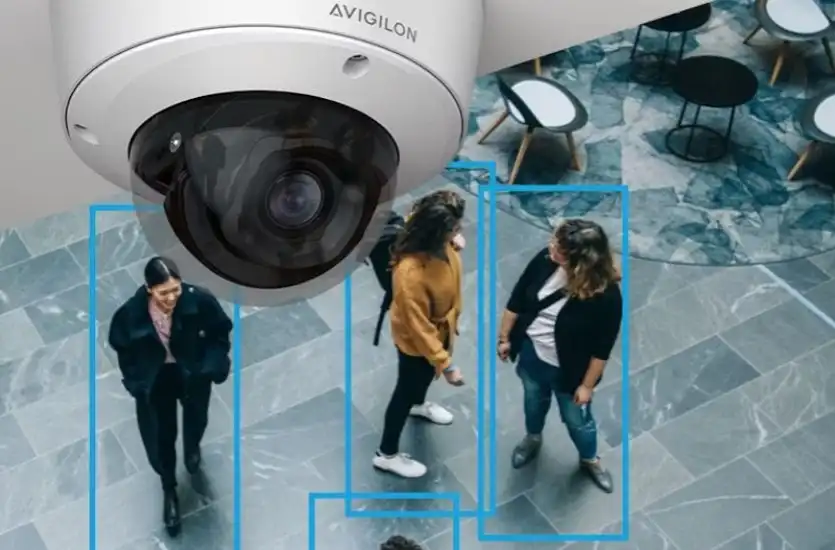If you work in the public sector, buying new security cameras isn’t as simple as comparing brands and price tags. Federal contracts and many state or municipal projects now require that every piece of equipment meet strict sourcing and cybersecurity standards. For buyers and integrators alike, that’s made procurement a little more complicated and far more regulated.
One of the biggest topics in physical security right now is NDAA compliance. The National Defense Authorization Act restricts the use of certain video surveillance and telecommunications equipment from companies linked to potential cybersecurity risks. That means if your organization uses federal funding or hopes to qualify for future grants, the cameras you install, and even the components inside them, must meet specific requirements. For this reason, many agencies are now prioritizing NDAA-compliant security cameras to safeguard their systems and maintain eligibility for federal projects.
In this article, we’ll explain what NDAA compliance really means, why it matters for public-sector buyers, and how U.S.-manufactured solutions like Avigilon can help you stay on the right side of today’s compliance landscape. We’ll also touch on the latest updates to the NDAA for Fiscal Year 2026 and what they could mean for your next procurement cycle.
What Is NDAA Compliance in the Context of Security and Telecom?
Before we get too far into discussing NDAA-compliant security cameras and their relevance, let’s align on just what NDAA compliance is in the first place.
Overview of the National Defense Authorization Act
The National Defense Authorization Act (NDAA) is an annual piece of federal legislation that outlines the budget, policies, and priorities for the U.S. Department of Defense. While its main purpose is to authorize military spending, the act often includes sections that affect federal procurement and technology use. In recent years, it has evolved to include measures aimed at strengthening national cybersecurity and protecting U.S. infrastructure from potential foreign threats, including restrictions on certain telecommunications and surveillance products.
Section 889 – What it Prohibits and Defines
The key portion for anyone involved in security procurement is Section 889 of the NDAA. This section bans federal agencies, and any organizations using federal funds, from purchasing, using, or even contracting with companies that use specific “covered telecommunications equipment or services.”
These typically refer to products developed or supplied by manufacturers linked to foreign governments or entities considered security risks. The most well-known examples are equipment from Huawei, ZTE, Hytera, Hikvision, and Dahua, as well as any subsidiaries or affiliates associated with them.
How It Applies to Video Surveillance, Cameras, and Network Gear
In practical terms, Section 889 impacts more than just cameras. It extends to the broader ecosystem that supports them, from network video recorders (NVRs) and encoders to routers, switches, and firmware.
Even if a security system seems compliant at the surface, any underlying component sourced from a prohibited manufacturer could still violate the act. This is why federal, state, and municipal buyers must verify not only the brand name on the device but also where the internal parts originate.
First-Party vs. Indirect Use and Supply Chain Implications
One of the trickiest aspects of NDAA compliance is that it covers both direct and indirect use. Direct use means an agency purchases or installs a banned product. Indirect use occurs when a non-compliant component, such as a chipset or camera module, is embedded within an otherwise approved system.
This creates a significant supply chain challenge for manufacturers and integrators, who must maintain clear documentation and traceability to confirm every piece of hardware, firmware, and software in their systems meets NDAA standards.
Why NDAA Compliance Matters
For public-sector organizations, NDAA compliance is a requirement tied directly to funding, eligibility, and public trust. When an agency installs non-compliant equipment, it risks far more than a technical violation. As we implied earlier, agencies can lose access to federal grants, face the cost of removing and replacing systems, or even compromise sensitive data and infrastructure.
The intent behind these restrictions is simple: to protect the country’s communications and surveillance networks from potential interference or data exposure. Security cameras, after all, don’t just watch over buildings; they often tie into networks that handle critical data. That’s why the government expects every agency and contractor to be able to verify the origin and integrity of the technology they use.
For agencies that depend on federal funding or contract work, staying NDAA compliant helps:
- Maintain eligibility for federal and state grants and contracts
- Prevent costly retrofits or equipment replacements later on
- Reduce cybersecurity and privacy risks tied to foreign-made components
- Protect against reputational damage if non-compliance is discovered
- Demonstrate transparency and accountability in procurement practices
Compliance also matters for integrators and resellers working with public-sector clients. Using or even connecting to non-compliant equipment can disqualify a company from future bids or ongoing service contracts.
Beyond the legal and financial impact, NDAA compliance represents a commitment to responsible technology sourcing and network security, both of which are becoming standard expectations across the security industry.

Recent Updates under the NDAA for FY 2026
The National Defense Authorization Act for Fiscal Year 2026 (S. 2296) includes several updates that affect public-sector technology procurement, especially for agencies that purchase or deploy security equipment.
Expanded transparency on waivers
The bill calls for more detailed reporting on waivers granted under NDAA provisions. Agencies seeking exemptions from certain restrictions will now face greater oversight, with waiver data expected to be publicly accessible. This change increases accountability and reinforces the expectation that exceptions are rare and well-justified.
Extended compliance timelines
Some deadlines related to Section 889 have been pushed back from December 2025 to December 2026. This extension gives agencies and contractors additional time to replace restricted equipment or verify supplier compliance without interrupting critical operations.
New manufacturers under review
S. 2296 directs the Department of Defense to evaluate whether TP-Link Technologies Co., Ltd. and its subsidiaries should be added to the list of restricted entities under Section 889. If adopted, this could further limit approved sourcing options for networking and surveillance hardware.
Broader supply-chain accountability
The bill strengthens domestic-sourcing requirements for key defense technologies, emphasizing U.S.-based manufacturing and oversight of high-risk components. Although not specific to cameras, this direction underscores the federal government’s increasing focus on secure, traceable supply chains.
What this means for public buyers
These updates point toward more transparency, stronger supply-chain scrutiny, and an expanding list of prohibited manufacturers. For public agencies, the main takeaways are clear: maintain accurate records of product origins, review supplier attestations regularly, and anticipate tighter oversight when purchasing new surveillance or communications systems.
U.S.-Manufactured / Compliant Camera Options
When a public-sector buyer needs cameras that genuinely meet NDAA standards, looking at U.S.-based manufacturers with transparent sourcing is often the safer bet. Avigilon is one company that emphasizes compliance; in its NDAA Compliance Guide, it clearly articulates that its products are built to support Section 889–compliant deployments.
Avigilon’s product lines include models such as the H6A Dome, H6A Bullet, H6A PTZ (pan, tilt, zoom), H5A Multisensor, and H5A Thermal, all offered as NDAA-compliant video devices in its published roster. Avigilon The company also points out that its cameras, software, and network components can be configured to meet FIPS standards and integrate into secure federal environments.
Another critical endorsement is that the Avigilon Unity on-premises video security suite has been added to the Department of Defense’s Information Network Approved Products List (DoDIN APL). That recognition signals that the suite meets demanding standards around data security, interoperability, and robustness suitable for federal operations.
That said, compliance doesn’t end at marketing claims. It also depends on firmware, updates, component sourcing, and supply-chain visibility. Selecting a vendor that is willing to provide clear documentation and supply-chain transparency helps reduce the risk that a system deemed “compliant” today later becomes non-compliant due to unseen changes.
Steps for Agencies, Integrators, and Buyers to Achieve Compliance
Getting to full NDAA compliance can feel overwhelming, but it doesn’t have to be. Whether you’re an agency, contractor, or integrator, these steps can help you stay on track and avoid surprises during audits or contract renewals.
- Review your current equipment inventory to identify any non-compliant devices
- Request written compliance statements from vendors and manufacturers
- Confirm that all components, including firmware and chipsets, meet NDAA requirements
- Replace or phase out restricted equipment as part of your upgrade plan
- Keep documentation of every purchase and compliance verification for future audits
- Schedule regular reviews to confirm ongoing compliance as rules evolve
Contact EMCI Wireless for NDAA Compliant Security Cameras
NDAA compliance has become a defining factor in how public agencies select and manage their security technology. It’s about protecting data, maintaining funding eligibility, and ensuring that surveillance systems meet the highest standards of trust and transparency. Choosing NDAA-compliant security cameras eliminates guesswork and future risk, particularly when those products are designed and manufactured in the United States.
Avigilon’s U.S.-made camera systems offer the reliability and documentation public-sector buyers need to stay compliant. Their clear supply-chain visibility and ongoing firmware support make it easier to maintain compliance without interrupting essential security operations.
At EMCI Wireless, we help agencies and contractors source, install, and maintain fully compliant camera solutions. Our team provides personalized guidance, equipment audits, and procurement support for organizations across central and southern Florida.
Contact us today to discuss your project, confirm compliance, or schedule a system assessment with our experts.

